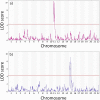Fine mapping of the Cepaea nemoralis shell colour and mid-banded loci using a high-density linkage map
- PMID: 37758900
- PMCID: PMC10673960
- DOI: 10.1038/s41437-023-00648-z
Fine mapping of the Cepaea nemoralis shell colour and mid-banded loci using a high-density linkage map
Abstract
Molluscs are a highly speciose phylum that exhibits an astonishing array of colours and patterns, yet relatively little progress has been made in identifying the underlying genes that determine phenotypic variation. One prominent example is the land snail Cepaea nemoralis for which classical genetic studies have shown that around nine loci, several physically linked and inherited together as a 'supergene', control the shell colour and banding polymorphism. As a first step towards identifying the genes involved, we used whole-genome resequencing of individuals from a laboratory cross to construct a high-density linkage map, and then trait mapping to identify 95% confidence intervals for the chromosomal region that contains the supergene, specifically the colour locus (C), and the unlinked mid-banded locus (U). The linkage map is made up of 215,593 markers, ordered into 22 linkage groups, with one large group making up ~27% of the genome. The C locus was mapped to a ~1.3 cM region on linkage group 11, and the U locus was mapped to a ~0.7 cM region on linkage group 15. The linkage map will serve as an important resource for further evolutionary and population genomic studies of C. nemoralis and related species, as well as the identification of candidate genes within the supergene and for the mid-banding phenotype.
© 2023. The Author(s).
Conflict of interest statement
The authors declare no competing interests.
Figures





References
-
- Abe M, Kuroda R. The development of CRISPR for a mollusc establishes the formin Lsdia1 as the long-sought gene for snail dextral/sinistral coiling. Development. 2019;146:dev175976. - PubMed
Publication types
MeSH terms
Grants and funding
LinkOut - more resources
Full Text Sources
Research Materials

